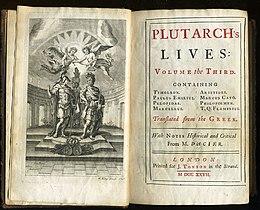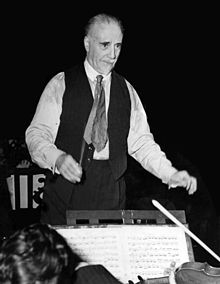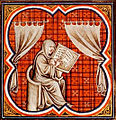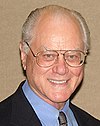Portal:Biography
The Biography Portal

A biography, or simply bio, is a detailed description of a person's life. It involves more than just basic facts like education, work, relationships, and death; it portrays a person's experience of these life events. Unlike a profile or curriculum vitae (résumé), a biography presents a subject's life story, highlighting various aspects of their life, including intimate details of experience, and may include an analysis of the subject's personality.
Biographical works are usually non-fiction, but fiction can also be used to portray a person's life. One in-depth form of biographical coverage is called legacy writing. Works in diverse media, from literature to film, form the genre known as biography.
An authorized biography is written with the permission, cooperation, and at times, participation of a subject or a subject's heirs. An autobiography is written by the person themselves, sometimes with the assistance of a collaborator or ghostwriter. (Full article...)
Featured biographies –
Pearl Jam is an American rock band formed in Seattle, Washington, in 1990. The band's lineup consists of founding members Jeff Ament (bass guitar), Stone Gossard (rhythm guitar), Mike McCready (lead guitar), and Eddie Vedder (lead vocals, guitar), as well as Matt Cameron (drums), who joined in 1998. Keyboardist Boom Gaspar has also been a touring/session member with the band since 2002. Former members include Dave Krusen (an original member), Matt Chamberlain, Dave Abbruzzese, and Jack Irons, all of whom were the band's drummers from 1990 to 1998. Pearl Jam has outsold and outlasted many of its contemporaries from the early 1990s, and is considered one of the most influential bands from that decade, dubbed "the most popular American rock and roll band of the '90s".
Formed after the demise of Gossard and Ament's previous bands, Green River and Mother Love Bone, Pearl Jam broke into the mainstream with their debut album, Ten, in 1991. Ten stayed on the Billboard 200 chart for nearly five years, and has gone on to become one of the highest-selling rock records ever, going 13× Platinum in the United States. Released in 1993, Pearl Jam's second album, Vs., sold over 950,000 copies in its first week of release, setting the record for most copies of an album sold in its first week of release at the time. Their third album, Vitalogy (1994), became the second-fastest-selling CD in history at the time, with more than 877,000 units sold in its first week. (Full article...)

Edward Benjamin Britten, Baron Britten OM CH (22 November 1913 – 4 December 1976, aged 63) was an English composer, conductor, and pianist. He was a central figure of 20th-century British music, with a range of works including opera, other vocal music, orchestral and chamber pieces. His best-known works include the opera Peter Grimes (1945), the War Requiem (1962) and the orchestral showpiece The Young Person's Guide to the Orchestra (1945).
Britten was born in Lowestoft, Suffolk, the son of a dentist. He showed talent from an early age. He studied at the Royal College of Music in London and privately with the composer Frank Bridge. Britten first came to public attention with the a cappella choral work A Boy Was Born in 1934. With the premiere of Peter Grimes in 1945, he leapt to international fame. Over the next 28 years, he wrote 14 more operas, establishing himself as one of the leading 20th-century composers in the genre. In addition to large-scale operas for Sadler's Wells and Covent Garden, he wrote chamber operas for small forces, suitable for performance in venues of modest size. Among the best known of these is The Turn of the Screw (1954). Recurring themes in his operas include the struggle of an outsider against a hostile society and the corruption of innocence. (Full article...)
William Samuel Sadler (June 24, 1875 – April 26, 1969) was an American surgeon, self-trained psychiatrist, and author who helped publish The Urantia Book. The book is said to have resulted from Sadler's relationship with a man through whom he believed celestial beings spoke at night. It drew a following of people who studied its teachings.
A native of Indiana, Sadler moved to Michigan as a teenager to work at the Battle Creek Sanitarium. There he met the physician and health-food promoter John Harvey Kellogg, co-inventor of corn flakes breakfast cereal, who became his mentor. Sadler married Kellogg's niece, Lena Celestia Kellogg, in 1897. He worked for several Christian organizations and attended medical school, graduating in 1906. Sadler practiced medicine in Chicago with his wife, who was also a physician. He joined several medical associations and taught at the McCormick Theological Seminary. Although he was a committed member of the Seventh-day Adventist Church for almost twenty years, he left the denomination after it disfellowshipped his wife's uncle, John Harvey Kellogg, in 1907. Sadler and his wife became speakers on the Chautauqua adult education circuit in 1907, and he became a highly paid, popular orator. He eventually wrote over 40 books on a variety of medical and spiritual topics advocating a holistic approach to health. Sadler extolled the value of prayer and religion but was skeptical of mediums, assisting debunker Howard Thurston, and embraced the scientific consensus on evolution. (Full article...)
Hannah Glasse (née Allgood; March 1708 – 1 September 1770) was an English cookery writer of the 18th century. Her first cookery book, The Art of Cookery Made Plain and Easy, published in 1747, became the best-selling recipe book that century. It was reprinted within its first year of publication, appeared in 20 editions in the 18th century, and continued to be published until well into the 19th century. She later wrote The Servants' Directory (1760) and The Compleat Confectioner, which was probably published in 1760; neither book was as commercially successful as her first.
Glasse was born in London to a Northumberland landowner and his mistress. After the relationship ended, Glasse was brought up in her father's family. When she was 16 she eloped with a 30-year-old Irish subaltern then on half-pay and lived in Essex, working on the estate of the Earls of Donegall. The couple struggled financially and, with the aim of raising money, Glasse wrote The Art of Cookery. She copied extensively from other cookery books, around a third of the recipes having been published elsewhere. Among her original recipes are the first known curry recipe written in English, as well as three recipes for pilau, an early reference to vanilla in English cuisine, the first recorded use of jelly in trifle, and an early recipe for ice cream. She was also the first to use the term "Yorkshire pudding" in print. (Full article...)
Felix of Burgundy (died 8 March 647 or 648), also known as Felix of Dunwich, was the first bishop of the kingdom of the East Angles. He is widely credited as the man who introduced Christianity to the kingdom. Almost all that is known about him comes from the Ecclesiastical History of the English People, completed by the English historian Bede in about 731, and the Anglo-Saxon Chronicle. Bede wrote that Felix freed "the whole of this kingdom from long-standing evil and unhappiness".
Felix came from the Frankish kingdom of Burgundy, and may have been a priest at one of the monasteries in Francia founded by the Irish missionary Columbanus—he may have been Bishop of Châlons, before being forced to seek refuge elsewhere. Felix travelled from Burgundy to Canterbury, before being sent by Archbishop Honorius of Canterbury to Sigeberht of East Anglia's kingdom in about 630 (travelling by sea to Babingley in Norfolk, according to local legend). Upon his arrival in East Anglia, Sigeberht gave him a see at Dommoc, possibly at Walton, Suffolk near Felixstowe, or Dunwich in Suffolk. According to Bede, Felix helped Sigeberht to establish a school in his kingdom "where boys could be taught letters". (Full article...)
Cyril Royston Guyton Bassett, VC (3 January 1892 – 9 January 1983) was a New Zealand recipient of the Victoria Cross (VC), the highest award for gallantry "in the face of the enemy" that could be awarded to British and Empire forces at the time. He was the only soldier serving with the New Zealand Expeditionary Force (NZEF) to be awarded the VC in the Gallipoli Campaign of the First World War.
Born in Auckland, Bassett was a bank worker when the First World War began. A member of New Zealand's Territorial Force, he volunteered for service abroad with NZEF and was posted to the New Zealand Divisional Signal Company as a sapper. He saw action on the opening day of the Gallipoli Campaign, and during the Battle of Chunuk Bair he performed the actions that led to his award of the VC. Medically evacuated due to sickness shortly after the battle, he later served on the Western Front and finished the war as a second lieutenant. Bassett returned to the banking profession but was recalled to active duty during the Second World War. He served on the Home Front and by the time he was taken off active duty in December 1943, he had been promoted to the rank of lieutenant colonel and was commander of signals in the Northern Military District. When he retired from his banking career he became a justice of the peace in Devonport. He died in 1983 at the age of 91. (Full article...)

The English poet Christopher Smart (1722–1771) was confined to mental asylums from May 1757 until January 1763. Smart was admitted to St Luke's Hospital for Lunatics, Upper Moorfields, London, on 6 May 1757. He was taken there by his father-in-law, John Newbery, although he may have been confined in a private madhouse before then. While in St Luke's he wrote Jubilate Agno and A Song to David, the poems considered to be his greatest works. Although many of his contemporaries agreed that Smart was "mad", accounts of his condition and its ramifications varied, and some felt that he had been committed unfairly.
Smart was diagnosed as "incurable" while at St Luke's, and when they ran out of funds for his care he was moved to Mr. Potter's asylum, Bethnal Green. All that is known of his years of confinement is that he wrote poetry. Smart's isolation led him to abandon the poetic genres of the 18th century that had marked his earlier work and to write religious poetry such as Jubilate Agno ("Rejoice in the Lamb"). His asylum poetry reveals a desire for "unmediated revelation", and it is possible that the self-evaluation found in his poetry represents an expression of evangelical Christianity. (Full article...)
John Milton Hay (October 8, 1838 – July 1, 1905) was an American statesman and official whose career in government stretched over almost half a century. Beginning as a private secretary and an assistant for Abraham Lincoln, he became a diplomat. He served as United States Secretary of State under Presidents William McKinley and Theodore Roosevelt. Hay was also a biographer of Lincoln, and wrote poetry and other literature throughout his life.
Born in Salem, Indiana to an anti-slavery family that moved to Warsaw, Illinois, Hay showed great potential from an early age, and his family sent him to Brown University. After graduation in 1858, Hay read law in his uncle's office in Springfield, Illinois, adjacent to that of Lincoln. Hay worked for Lincoln's successful presidential campaign and became one of his private secretaries in the White House. Throughout the American Civil War, Hay was close to Lincoln and stood by his deathbed after the President was shot. In addition to his other literary works, Hay co-authored, with John George Nicolay, a ten-volume biography of Lincoln that helped shape the assassinated president's historical image. (Full article...)















































